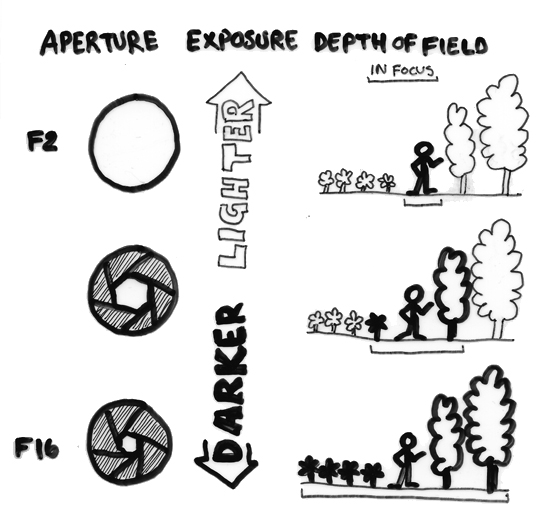Manual photography - so simple in principal, yet so damn brain bending when you think about it all at once. Let’s start with A, for Aperture…
Aperture
The aperture is the opening in the lens that lets light through to either expose the film or the sensor.
F-numbers are the unit used to indicate how much light is being let in.
The more open it is (which corresponds with a small f-number on your camera) the more light comes in.
The more closed it is (which corresponds with a large f-number) the less light is let in.
(Think about the way your own pupils work - on a bright day they will be small, whereas in the dark to help you see, your pupils dilate to let in more light)
A small f number = large opening = more light coming in
A large f number = a small opening = less light coming in

So far, so simple…
The aperture also influences the depth of field.
Depth of field is the area in front and behind the subject that is in focus.
A small f number (large opening) = a smaller area in focus
A large f number (small opening) = a larger area in focus
So, if you want everything in your image to be in focus, choose a large f number.
If you want to blur out the background in an image pick a small f number.
Another thing that influences depth of field is distance – the greater the distance between you and your subject, the greater the depth of field.
One more thing…
Light conditions - Aperture is linked to shutter speed!
The longer the shutter is open, the more light it lets in (and the more movement is captures because it is open longer).
Slower shutter speed (more light let in) = more time open = blurred subject
Fast shutter speed (less light let in) = less time open = frozen subject
Slower shutter speeds can compensate for when your aperture is letting less light in (because you want a larger area of your picture in focus)
Large f number (small opening) = larger area in focus but less light means could be under exposed.
Using a slow shutter speed will let more light in, but you risk a blurry image.
If you don’t want motion blur, you will have to either sacrifice how much of your picture is in focus or how bright your picture is.
Faster shutter speeds can compensate for when your aperture is letting a lot of light in (because you want a smaller area of your picture in focus)
Small f number (large opening) = smaller area in focus but too much light means it could be over exposed.
Using a faster shutter speed will let less light in, but it means you won’t be able to capture movement in your subject.
If you want to capture movement, you will either have to have more of your picture in focus (to make the aperture smaller) allowing you to have a slower shutter speed or risk having an over exposed image.
There are other factors involved, including film speed and lens type, but the aim here is to keep it simple. Once you start practicing, and can understand how aperture, depth of field and shutter speed interact with each other, you will have much more control over the outcome of your images!

Just a comment. i trust you don't mind... You say "the greater the distance between you and your subject, the greater the depth of field." Technically, not really correct, although it has been repeated in many places by authors who should know better. What actually is going on is that the greater the distance from the subject, the more "telephoto" (longer focal length) you have probably selected and this is the fact that causes the background to appear closer and more connected to the subject. This effect is also intimitely connected with the "hyperfocal length" concept. 1/3 in front and 2/3 behind the prime focus point for the DoF. Thus the DoF can appear wider, although it actually isn't.
Thanks. I'll just keep plugging away at it.
It represent the ratio of the focal length of the lens to the diameter of the lens diaphragm opening.
The reason we use the ratios instead of the actual surface area of the diaphragm opening is that the actual surface area would be quite different between lenses of different focal lengths.
http://www.fredparker.com/ultexp1.htm#EV
That way you have a common reference on lenses.